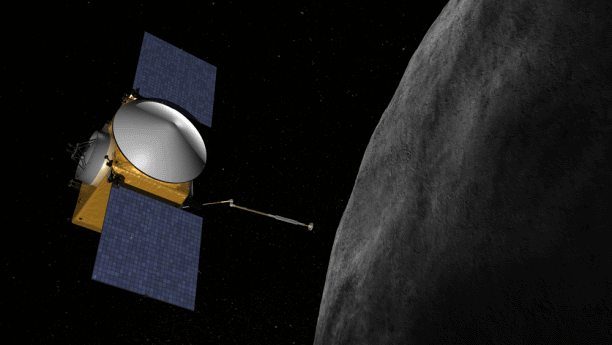May 1, 2013
The target of NASA's OSIRIS-REx spacecraft is an asteroid that has had the provisional name (101955) 1999 RQ36. Believing the asteroid deserved a more memorable name, the OSIRIS-REx team, led by the University of Arizona, partnered with The Planetary Society and MIT's Lincoln Laboratory, which discoverered the asteroid, to sponsor a contest to rename the asteroid.
More than 8,000 students from more than 25 countries entered the Name that Asteroid! contest. The International Astronomical Union approved the name, Bennu, in late April.
Judges enjoyed reading through the imaginative and informative entries. Dante Lauretta, principal investigator of the OSIRIS-REx mission and one of the judges, said, "There were many excellent entries that would be a fitting name and would provide us an opportunity to educate the world about the exciting nature of our mission."
The judges had to make a choice, however, and now the asteroid formerly known as (101955) 1999 RQ36 has a new name – (101955) Bennu.
The OSIRIS-REx spacecraft will launch in 2016, rendezvous with Bennu in 2018 and take a sample in 2019. The spacecraft will return a small sample of the asteroid to Earth in 2023.
Bennu was an important avian deity in ancient Egypt and one of the symbols of Osiris. Egyptians usually depicted Bennu as a gray heron. The dual nature of asteroids, bringers of life's molecules and sometime bringers of destruction, inspired the name.
The contest winner, 9-year-old Michael Toler Puzio from North Carolina, suggested that the large heron-like Touch-and-Go Sample Mechanism (TAGSAM) arm and winged OSIRIS-REx spacecraft made him think of Bennu. Puzio stated, "The winged OSIRIS-REx and its heron-like TAGSAM also evoke attributes of Bennu, as does the egg shape of the asteroid itself."
Bruce Betts, director of projects for the Planetary Society and another judge in the contest, said: "Bennu stuck a chord with many of us right away. While there were many great entries, the similarity between the image of the heron and the TAGSAM arm of OSIRIS-REx was a clever choice. The parallel with asteroids as both bringers of life and as destructive forces in the solar system also created a great opportunity to teach."
The heron-TAGSAM and egg-asteroid parallels weren't the only similarities that struck the judges. The god Bennu was commonly associated with the gods Atum, the primeval deity, and Re, the sun god. Astronomers think that the OSIRIS-REx target asteroid is a primitive object that dates back to the creation of the solar system because earthly analogues for the asteroid Bennu are carbonaceous chondrite meteorites, which have compositions very similar to that of the sun. Indeed, our own long-lived solar system was "reborn" from the remnants of stellar explosions more than 4.5 billion years ago. Therefore, origins, rebirth and duality are all part of the story of this asteroid.
The naming contest was a partnership among the UA, The Planetary Society and MIT's Lincoln Near-Earth Asteroid Research (LINEAR) asteroid survey. Contestants submitted one name along with a short explanation for their choice.
The partners assembled a panel to review the submissions and to submit a top choice to the International Astronomical Union (IAU) Committee for Small Body Nomenclature, which approved the name. Names were required to comply with naming guidelines from the IAU.
"We are so impressed with the quality of the contest entries that we have decided to recommend four runner-up submissions as names for other minor planets discovered by the LINEAR program," said judge Grant Stokes, head of the Aerospace Division at MIT Lincoln Laboratory and principal investigator for the LINEAR program. "The names Muninn, Nabu, Polymatheia and Ragnarok will be submitted to the IAU as recommended names."
Students living in the United States and Brazil provided these four names.
The OSIRIS-REx mission has also invited the contest winner and runners-up to provide messages on the microchip that will travel to Bennu and return. The microchip will contain names of thousands of people from around the world. Watch for more information about this activity in summer 2013.













